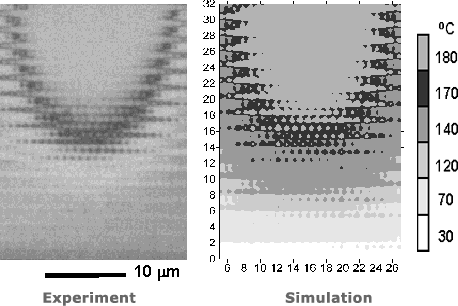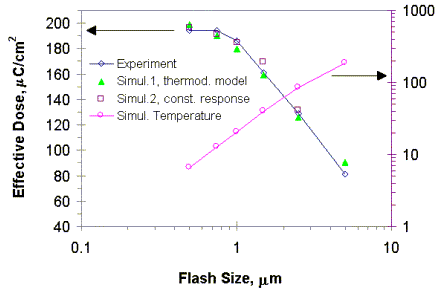Performance
Experimental verification demonstrated great correspondence between the simulated and experimental results.
Qualitative Experimental Verification

A subfield is uniformly exposed using a variably shaped beam. The exposure starts at the bottom left corner, moves to the right and then back up in a serpentine. The temperature increases as long as the subfield is exposed. The residual resist thickness after partial development demonstrates an effective dose change due to heating. A very close correspondence between the experimental and predicted data is observed in long range and short range resist heating.
Quantitative experimental verification

A comparison of the experimental and simulated data is shown as the effective dose change due to heating as a function of the flash size. 30 kV, PMMA on glass/chrome, VSB exposure. The temperature was simulated; then a thermodynamic model and a linear model of resist response to heating were used to simulate the effective dose.
TEMPTATION vs. ANSYS software
ANSYS is a finite elements software which is used for temperature simulations. Any finite elements software involves a trade-off between accuracy and the speed of the simulation. The finer the simulation grid is, the longer it takes to simulate.
TEMPTATION uses an analytic model. Therefore, a trade-off between the speed and accuracy of the simulation does not exist. A comparison of the simulation speeds of these two softwares is shown below. For much more complicated tasks using a much cheaper computer, TEMPTATION completes the task in a shorter time. Aditionally, the analytical model allows TEMPTATION to handle millions of flashes, which is not possible with any finite element software.
| Software | Task | Time to simulate |
| ANSYS | 150 flashes | 28 hrs |
| TEMPTATION | 10000 flashes | 3 min |
More information on the performance of the TEMPTATION software can be found in the paper "Experimental verification of the TEMPTATION (temperature simulation) software tool", Journal of Vacuum Science and Technology, B16(6), 1998, p.2341, as well as in other references.
